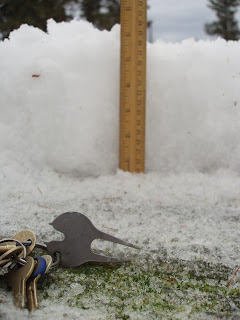It has been relatively quite this past couple weeks with no real news to report. The snow is always nice and far better than rain. The last couple dumps have added another 8" over the hard dense layer to get the snow pack up to a respectable 16 or so inches (similar to other years at this time give or take a couple inches).
 |
| 14" total snow in this picture |
Since taking the previous picture we've had another 3 to 4 inches of snow.
I did take some samples from greens earlier this month to get feel for what may be going on. The frozen ground dictates a slightly different tool selection than normal.
 |
| Old cup cutter and sledge hammer are the only way to get samples |
The problem with frozen ground is the difficulty in pulling a complete plug. Basically, all you really get is small slice that seems to break at the interface between the sand and thatch.
 |
| Fresh Plug, 12 Green |
My first plug was from 9 green since it is the one of the ones I am concerned about. After digging and chipping I was able to do a little "scratch and sniff". As flaky as this sounds, the process involves closing my eyes, clearing my thoughts, inhaling deeply and letting the smell tell my brain what to think. I've said it before and I'll say it again, but when I smell grass in the middle of winter I automatically think of the color green. This time out, however, I smelled sour which for me triggers a brown color in my minds eye. I pulled a plug and brought it indoors and was glad to see it green up and grow. The weird part it is only the Poa growing. My guess is since the plug was difficult to remove and very, very shallow most of the roots (and possibly crowns) from the bentgrass would have been left behind in the frozen ground and, as a result, any bentgrass leaf tissue would all fail to grow.
I've been out to the other greens with ice on the surface and early indications (smell and, as in the case of the plug pictured above from 12 green) appear less threatening than those so far observed on 9 green. The plan is still to monitor the surface as best we can by randomly digging test pits and pulling plugs if conditions (i.e. smell) dictate it throughout the remainder of the winter. I'll check the greens tarped with the semi-permeable covers next week and comment on any thing I see.






